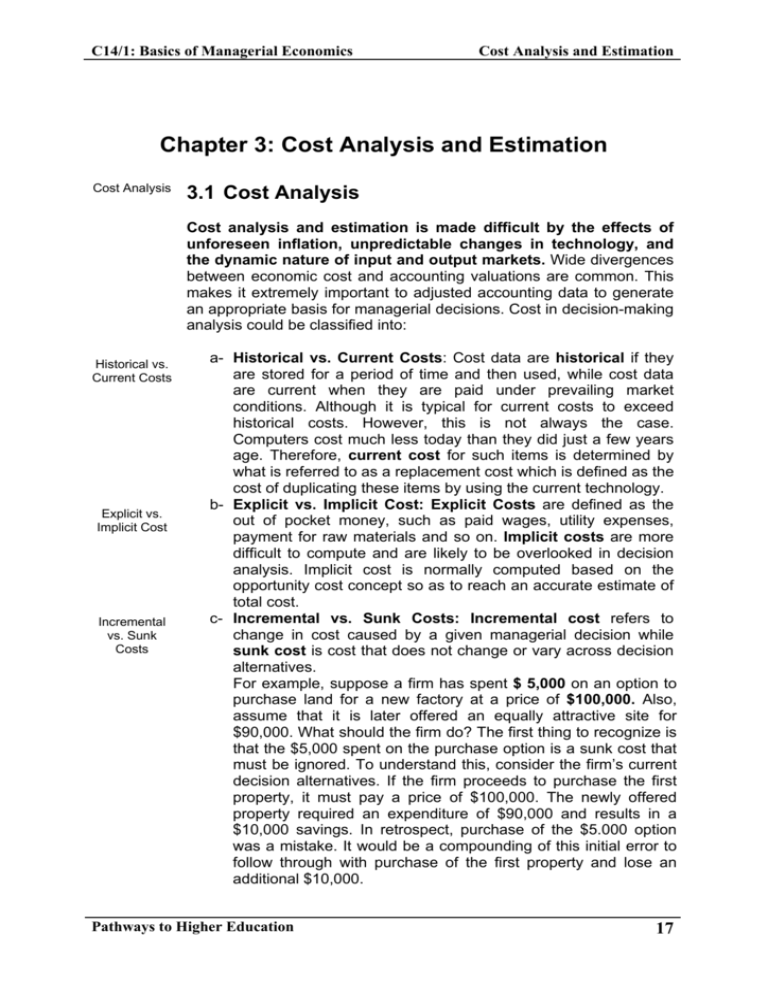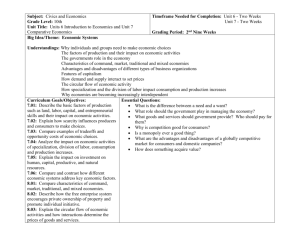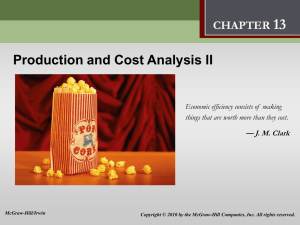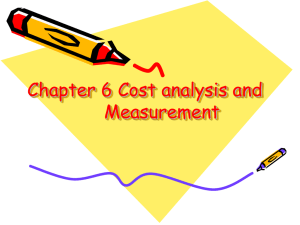Chapter 3: Cost Analysis and Estimation
advertisement

C14/1: Basics of Managerial Economics Cost Analysis and Estimation Chapter 3: Cost Analysis and Estimation Cost Analysis 3.1 Cost Analysis Cost analysis and estimation is made difficult by the effects of unforeseen inflation, unpredictable changes in technology, and the dynamic nature of input and output markets. Wide divergences between economic cost and accounting valuations are common. This makes it extremely important to adjusted accounting data to generate an appropriate basis for managerial decisions. Cost in decision-making analysis could be classified into: Historical vs. Current Costs Explicit vs. Implicit Cost Incremental vs. Sunk Costs a- Historical vs. Current Costs: Cost data are historical if they are stored for a period of time and then used, while cost data are current when they are paid under prevailing market conditions. Although it is typical for current costs to exceed historical costs. However, this is not always the case. Computers cost much less today than they did just a few years age. Therefore, current cost for such items is determined by what is referred to as a replacement cost which is defined as the cost of duplicating these items by using the current technology. b- Explicit vs. Implicit Cost: Explicit Costs are defined as the out of pocket money, such as paid wages, utility expenses, payment for raw materials and so on. Implicit costs are more difficult to compute and are likely to be overlooked in decision analysis. Implicit cost is normally computed based on the opportunity cost concept so as to reach an accurate estimate of total cost. c- Incremental vs. Sunk Costs: Incremental cost refers to change in cost caused by a given managerial decision while sunk cost is cost that does not change or vary across decision alternatives. For example, suppose a firm has spent $ 5,000 on an option to purchase land for a new factory at a price of $100,000. Also, assume that it is later offered an equally attractive site for $90,000. What should the firm do? The first thing to recognize is that the $5,000 spent on the purchase option is a sunk cost that must be ignored. To understand this, consider the firm’s current decision alternatives. If the firm proceeds to purchase the first property, it must pay a price of $100,000. The newly offered property required an expenditure of $90,000 and results in a $10,000 savings. In retrospect, purchase of the $5.000 option was a mistake. It would be a compounding of this initial error to follow through with purchase of the first property and lose an additional $10,000. Pathways to Higher Education 17 C14/1: Basics of Managerial Economics Short-Run vs. Long-Run Cost Cost Analysis and Estimation d- Short-Run vs. Long-Run Cost: Short-run cost is the cost of production at various production (output) levels for a specific plant size and a given operating environment. There for total short-run cost can be classified into fixed cost (FC) which is known as contractual costs in the long-run (rent, interest payments, and overhead cost) and variable cost (VC) such as wages, cost of raw material, power bills, and so on, as shown in Figure 3.1. a) Total cost (TC) = FC + VC b) Average cost (AC) AFC = FC Q VC AVC = Q AC = AFC + AVC = TC Q c) Marginal Cost (MC) = ∆TC ∆VC = ∆Q ∆Q Figure 3.1: Short-run and long-run cost Numerical Example: Long-run cost Q 1. TC $ 120 TFC $ 100 TVC $ 20 2. 3. 4. 5. 6. 7. 8. 9. 10. 138 151 162 175 190 210 234 263 300 100 100 100 100 100 100 100 100 100 38 51 62 75 90 110 134 163 200 ATC $ 120.0 69.0 50.3 40.5 35.0 31.7 30.0 29.3 29.2 30.0 AFC $ 100 AVC $ 20.0 MC $ 20 50.0 33.3 25.0 20.0 16.7 14.3 12.5 11.1 10.0 19.0 17.0 15.5 15.0 15.0 15.7 16.8 18.1 20.0 18 13 11 13 15 20 24 29 37 a. Long-run cost: In the long-run all costs are variable costs. It shows the cost of production at various plant size or scale and operating conditions. It reflects the economies, diseconomies of scale, and optimal plant sizes which are a helpful guide for decisions-making process, as shown in Figure 3.2. Pathways to Higher Education 18 C14/1: Basics of Managerial Economics Cost Analysis and Estimation SRAC 2 dgdsg LARC LRAC dddaSSD SRAC 3 wdfwf 0 X Z Economies of scale Diseconomies of scale Optimal plant size Figure 3.2: Long-run cost Economies vs. Diseconomies of Scale Economies vs. Diseconomies of Scale Economics of scale exist when long-run average cost (LRAC) declines with enlarging the size of the as output expands along with the plant size due to labor specialization, applying better technology, commercial, financial-managerial advantages, and also through learning economies. Diseconomies of scale exist when long-run average cost (LRAC) increase as output along with the plant size enlarges. This cost increases due mainly to administrative disadvantage of large scale when the firm size expand beyond the optimal size. Learning curve concept Learning curve concept When knowledge gained from manufacturing, experience is used to improve production methods. This accumulated “know how” result in a decline in the LRAC is said to reflect itself in the firm’s learning curve. Estimate of Cost & Profit Maximization 3.2 Estimate of Cost & Profit Maximization The shape of LRAC curve is important not only because of its implications for plant scale decision but also because of its effects on the potential level of competition especially when it declines in some industries. Normally firms encounter a (U) shaped LRAC while other firms encounter an (L) shape LRAC. Insight of the competitive implications of cost/output relation can be gained by estimating the minimum LRAC (Plant optimal size), as shown in Figure 3.3. Pathways to Higher Education 19 C14/1: Basics of Managerial Economics Cost Analysis and Estimation LRAC LRAC Q1 * 0 0 Output Scale Q2 * Output Scale Figure 3.3: Estimate of cost and profit Estimate of Minimum Efficient Scale (MES) 3.3 Estimate of the Minimum Efficient Scale (MES) MES is determined at the minimum point of U-shaped LRAC curve, (Q1) or the minimum point of L-shaped LRAC curve (Q2). The following numerical example explains the underlined concept. Profit Maximization: The following example shows the procedures of how profit is maximized: Assume that (X) company has the following: 1) P = 940 – 0.02 Q (estimated demand equation) MR = 940 – 0.04 Q (estimated Marginal equation) Revenue-derived (estimated total cost equation) 2) TC = 250000 + 40 Q + 0.01 Q2 Mc = 40 + 0.02 Q (derived marginal cost equation profit identity. π = TR – TC = (p) (Q) – TC = (940 – 0.02 Q) Q – (250000 – 40 Q – 0.01 Q2) = - 0.03 Q2 + 900 Q – 250000 The profit-maximizing activity level with centralized production is the output level at which marginal profit (MH) = MR – MC = 0 and, therefore, MR=MC. Setting marginal revenue (MR) equal to marginal cost (MC) and solving for the related output quantity as follows: MR = MC $940 - $0.04Q = $40Q + $0.02Q $0.06Q = $900 Q = 15000 Pathways to Higher Education 20 C14/1: Basics of Managerial Economics Cost Analysis and Estimation At Q = 15000, Profit will be maximized at the following calculated. P = $940 - $0.02Q = $940 - $ 0.02 (15000) = $640 And maximum profit is calculated as follows: π = -$0.03(15000)2 + $900(15000) - $250000 = $6500.000 Economies of Scope Concept Exploiting Economics of Scope Economies of Scope Concept: Economies of scope exist when the cost of joint production is less than the cost producing multiple outputs separately. In other words, a firm will produce products that are complementary in the sense that producing them together costs less than producing them individually. Suppose that a regional airline offers regularly scheduled passenger service between midsize city pairs and that it expects some excess capacity. Also, assume that there is a modest local demand for air parcel and small- package delivery service. Given current airplane sizes and configurations, it is often costly for a signal carrier to provide both passenger and cargo services in small regional markets than to specialize in one or the other. Thus, regional air carriers often provide both services. This is an example of economies of scope. Other example of scope economies abound in the provision of both goods and services. In fact, the economies of cope concept explain why firms typically produce multiple products. Also, studying economies of scope forces management to consider both direct and indirect benefits associated with individual lines of business. Exploiting Economies of Scope Economies of scope are important because they permit a firm to translate superior skill in a given product line into unique advantages in the production of complementary products. Effective competitive strategy often emphasized the development or extension of product lines related to a firm’s current stars, or areas of recognized strength. For example, PepsiCo, Inc. has long been a leader in the soft drink market. Over time, the company has gradually broadened its product line to include various brands of regular and diet soft drinks. Fritos and Doritos Corn chips, Grandma are Cookies, and other snack foods. PepsiCo can no longer be considered just a soft drink manufacturer. It is a widely diversified snack foods company for whom well over onehalf of total current profits come from non-soft drink line. PepsiCo snack foods product line extension strategy was effective because it capitalized on the distribution network and marketing expertise developed in the firm’s soft drink business. In the case of PepsiCo, snack foods and soft drinks are good example of how a firm has been able to take the skills gained in developing one star (soft drinks) and use them to develop a second star (snack foods). Pathways to Higher Education 21 C14/1: Basics of Managerial Economics Cost Analysis and Estimation The economies of scope concept offer a useful means for evaluating the potential of current and prospective lines of business. It naturally leads to definition of those areas in which the firm has a comparative advantage and its greatest profit potential. Break-Even Analysis & Operating Leverage 3.4 Break-Even Analyzing & Operating Leverage Breakeven analysis called Cost-volume-profit analysis is an important analytical technique used to study relations among costs, revenues, and profit. Both graphic and algebraic methods are used. For simple problems, simple graphic methods work best. In more complex situations, analytic methods, possibly involving spreadsheet software programs, are preferable, as shown in Figure 3.4. Tc 240 Total revenue Tr 210 Breakeven point 180 Net Profit Profit Total Cost 150 Variable Cost 120 90 Loss Fixed Cost 60 Fixed Cost 30 0 10 20 30 40 50 60 70 80 Figure 3.4: Cost-volume profit Chart A basic cost-volume-profit chart composed of a firm’s total cost and total revenue curves is depicted in Figure 3.4. Volume of output is measured on the horizontal axis; revenue and cost are shown on the vertical axis. Fixed costs are constant regardless of the output produced and are indicated by horizontal line. Variable costs at each output level are measured by the distance between the total cost curve and the constant fixed cost. The total revenue curve indicates the price/demand relation for he firm’s product; profits or losses at each output are shown by the distance between total revenue and total cost curves. In the example depicted in Figure 3.4, fixed costs of $60000 are represented by a horizontal line. Variable costs for labor and materials are $1.80 per unit, so total costs rise by that amount for each additional unit of output. Total revenue based on a price of $3 per unit is a Pathways to Higher Education 22 C14/1: Basics of Managerial Economics Cost Analysis and Estimation straight line through the origin. The slope of the total revenue line is steeper than that of the total cost line. Output levels below the breakeven point produce losses. As output grows beyond the breakeven point; increasingly higher profits results. Degree of Operating Leverage Degree of Operating Leverage Cost-volume-profit: analysis also a useful tool for analyzing the financial characteristics of alternative production systems. This analysis focuses on how total costs and profits vary with operating leverage or the extent to which fixed production facilities are used. The relation between operating leverage and profits is shown in Figure 3.5, which contrasts the experience of three firms, A, B, and C, with differing degrees of leverage. The fixed costs of firm B are typical. Firm A uses relative less capital equipment and has lower fixed costs, but it has a steeper rate of increase in variable costs. Firm A breaks even at a lower activity level than does firm B. For example, at a production level of 40000 units, B is losing $8000 but breaks even. Firm C is highly automated and has the highest fixed costs, but it variable costs rise slowly. Firm C has a higher breakeven point than either A or B, but once C passes the breakeven point, profits rise faster than those of the other two firms. The degree of operating leverage is the percentage changes in profit that results from 1% change in units sold: Percentage Change in Pr ofit Degrree of Operating Leverage = …… (11) Percentage Change in Sales The degree of operating leverage is an elasticity concept. It the elasticity profits with respect to output. When based on linear cost and revenue curves, this elasticity will vary. The degree of operating leverage is always greatly close to the breakeven point. For firm B in Figure 3.5, the degree of operating leverage at 100000 units of output is 2.0, calculated as follows: DOL = 40% =2 20% Pathways to Higher Education 23 C14/1: Basics of Managerial Economics Cost Analysis and Estimation Tc TR Tc TR Tc TR Figure 3.5: The degree of operating leverage Pathways to Higher Education 24







